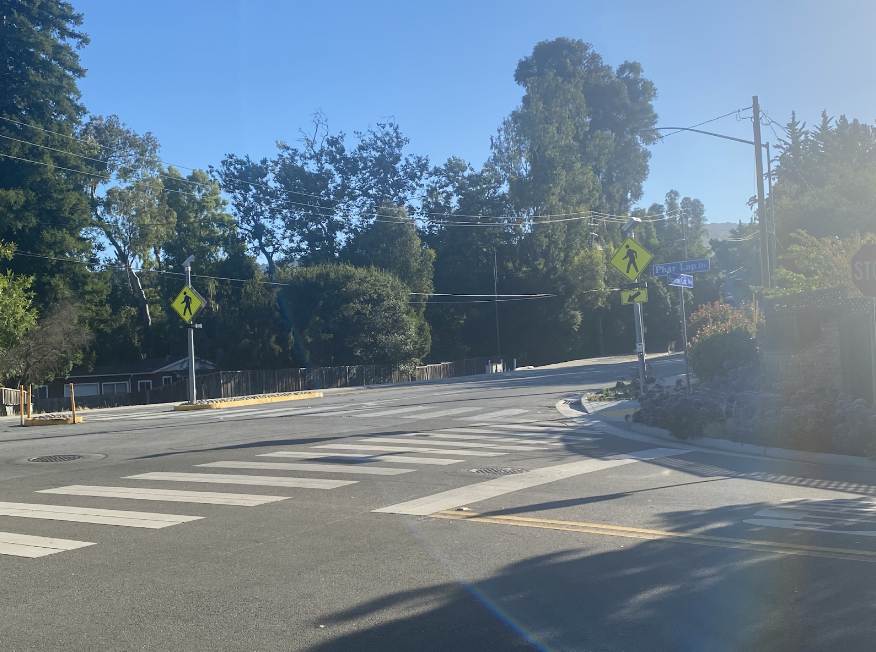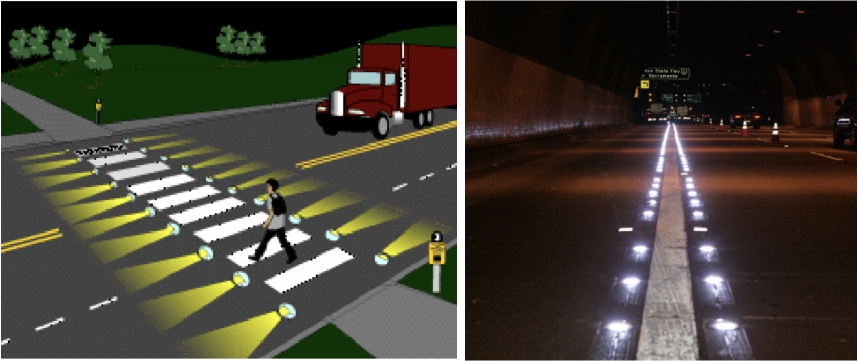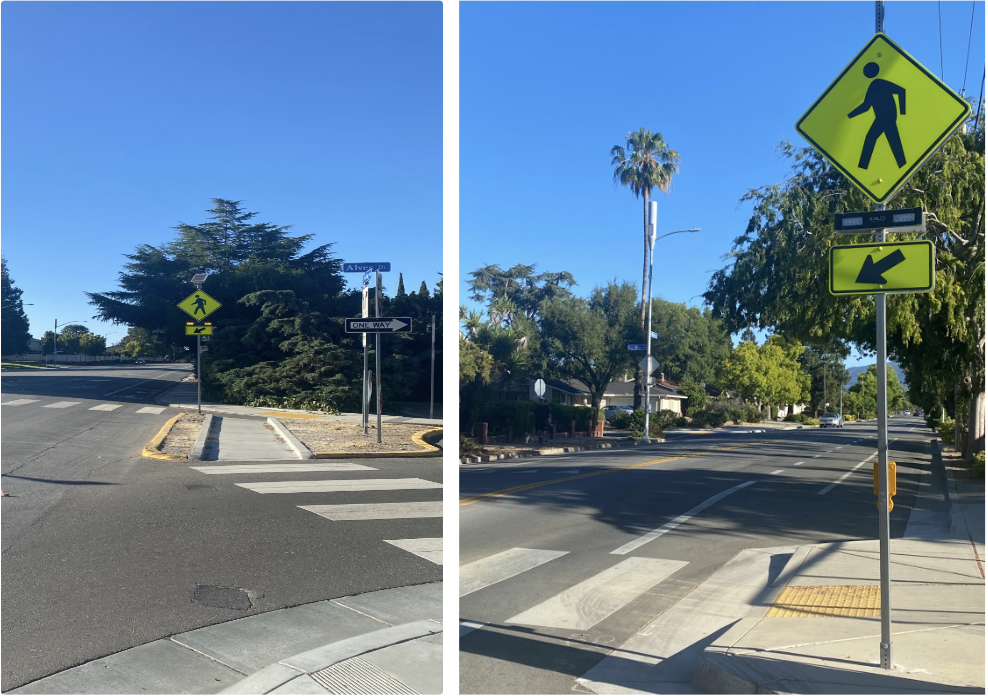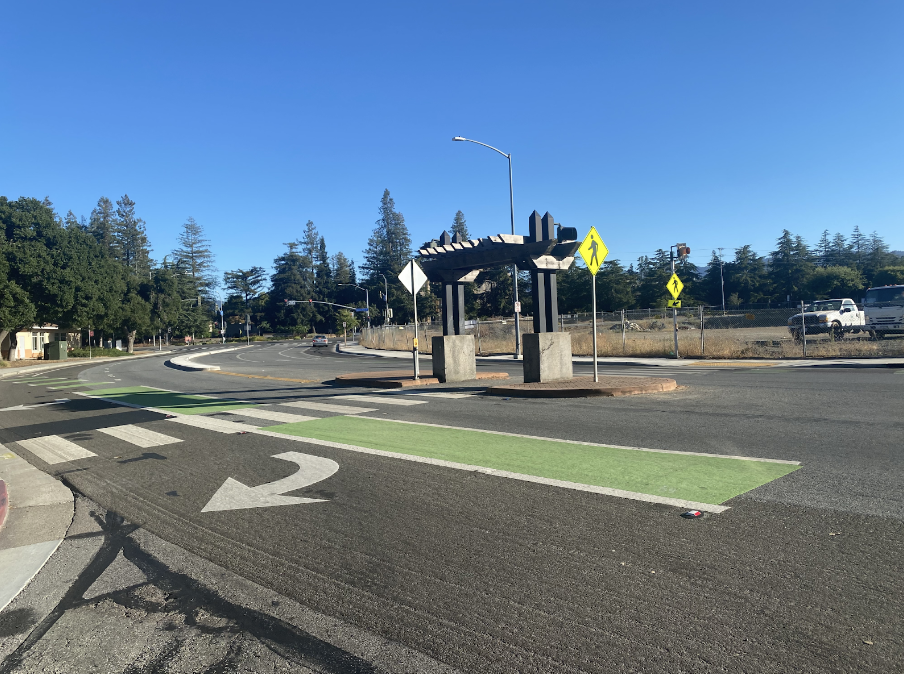It can sometimes be easy to underestimate the impact of one small blinking light, yet a small blinking light is capable of creating a driver yield rate of greater than 70%!
RRFBS: Rectangular Rapid Flashing Beacons
Crosswalks equipped with blinking lights, known as rectangular rapid flashing beacons (RRFBs) to city engineers, can significantly improve pedestrian safety. These beacons prompt drivers to yield at midblock crossings, telling vehicles to brake for crossing bicycles and pedestrian traffic. This not only eases the pressure on pedestrians and cyclists, who can now safely cross, but also helps cautious drivers by providing clearer visibility both day and night.
RRFBs offer a practical solution to addressing the hundreds of crosswalk incidents that occur daily. Unlike hybrid beacons (see graphic below) or traffic signals, blinking lights are cost-effective and do not require a tedious installation process.

An RRFB in Cupertino at the intersection of Phar Lap and Stevens Creek Boulevard.
A comparison of RRFBs and Hybrid Beacons shows RRFBs require a lot less infrastructure work.
In-Pavement Lighting Systems
Beyond their use on crossing signs, blinking lights are being used in other ways to offer protection for cyclists. In-pavement lighting systems offer new ways to show vehicle traffic that cyclists will be passing through or riding alongside at night.
The City of Cupertino usually prefers not to use this type of lighting, primarily due to its high cost and lack of reliability in comparison to the RRFB system.
Two examples of in-pavement lighting systems.

Photos courtesy of SemanticsScholar and Furrloveov
Cupertino uses Rectangular Rapid Flashing Beacons (RRFB’s), rather than in-pavement flashing lights, to enhance safety for pedestrians using uncontrolled street crossings. RRFB’s have been found to be similarly effective as in-pavement flashing lights, but with a significantly lower cost and greater reliability. Although quantitative data relating to the improvement of safety is not readily available for these RRFB’s, Cupertino and other similar communities have found that the installation of RRFB’s substantially increases the rate at which drivers yield to pedestrians and reduces the frequency of pedestrians crossing outside of the crosswalk.
With the presence of an RRFB, pedestrian crashes decrease on average by nearly 47%!

(Left) The intersection of Stelling and Alves Drive. (Right) Blaney Avenue at the crossing of the Regnart Trail–a Walk Bike Cupertino favorite 🙂
Let’s add more RRFBs
Because of their ability to increase safety, adding blinking lights at crosswalks near areas with high pedestrian traffic would be very beneficial. This includes crosswalks near libraries, churches, schools, shopping centers, and parks.
For example, RRFBs could be added to the crosswalks on Torre Avenue (near the Cupertino library) or the intersection of Byrne and McClellan (near Lincoln Elementary) or the intersection of Pasadena and Stevens Creek Boulevard (near the Post Office). All of these locations would benefit from blinking lights.
Conclusion
RRFBs and blinking lights are now used in a multitude of intersections and crosswalks around the world. Combining their visual cue with additional safety measures can create an even stronger traffic safety system. For example, most blinking light systems today lack audio systems and speakers that can be crucial during the daytime when the lights are harder to see or for users that are sight-impaired. In the future, enhancing our blinking light systems with audio alerts could further protect cyclists and pedestrians.

RRFBs on Mary Avenue at the exit from Memorial Park
These systems are sure to be continued to be used in Cupertino due to their effectiveness. Let us know if there is a spot in Cupertino where you would recommend adding RRFBs by emailing us at info@walkbikecupertino.org or in the comments below.
